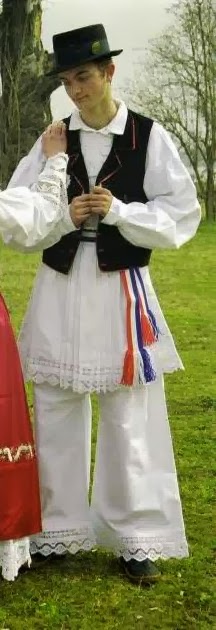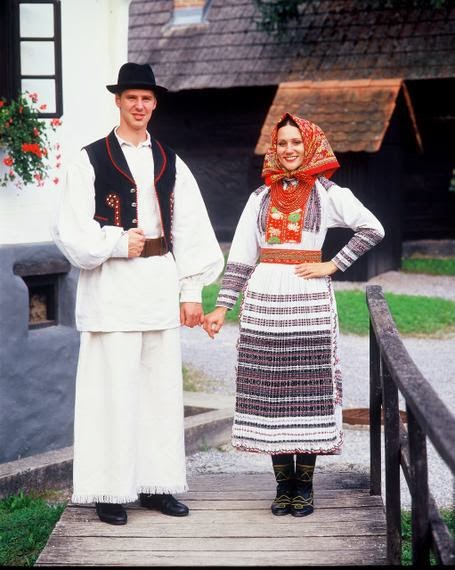Hello all,
Croatia is a rather small country, but has an amazing number and variety of Folk Costumes. The basic difference between Croatians, Serbs and Bosniaks is nominally religion. Croatians are Roman Catholic, Serbs are Byzantine Orthodox, and Bosniaks are Muslim. Other differences are strictly local. There is no correspondence between a map of the three nationalities with the political borders, the various dialects, the various types of costumes, cultural zones, etc. Today, of course, many people have a deep seated sense of nationality, so it has become a part of their personal identity.
The Pannonian zone is comprised of the lowland areas of eastern Croatia, as well as northern Bosnia and Vojvodina. The costumes of this zone bear far more resemblance to each other than they do to other parts of any of these three countries.
Compare these two photos, the first is of a Serbian man from Slavonia, the second of a Croatian man from Slavonia.
The two sashes each have the stripes ordered according to the appropriate national flag, but that is the only significant difference.
On a map of Croatia, the Pannonian zone makes up the eastern half of the country, from the narrow waist.
I will be referring to the costumes according to their traditional cultural areas, which do not match current political divisions; this map above shows their approximate locations.These areas are often bounded by geographical features.
I will cover the areas roughly from west to east.
This map will be of some help, although many of the villages mentioned are not shown. It may be helpful to open Google maps and look up the villages as they are mentioned.
I need to stress that while I will include many costumes, this presentation is NOT exhaustive.
1. POKUPLJE
This area is in the western part of pannonian Croatia and basically consists of the basin of the Kupa river, which rises in the Dinaric mountains and passes Karlovac on its way east to drain into the Sava river.
From west to east:
Western group:
Karlovac
Draganić
Songs and dances from this region
https://www.youtube.com/watch?v=QogQpvgBAR0
Rečica
Eastern group
Kupinec
Bratina
Costume parade in Bratina
https://www.youtube.com/watch?v=72tpiP9Cwa0
Jamnica
The pleats typical of this costume make the entire outfit come alive when doing the typical Croatian shake dances.
A commercial showing some dancing from Jamnica
https://www.youtube.com/watch?v=OzysdQL-x2Y
A medley of songs and dances from Pokuplje, showing three of the costumes
https://www.youtube.com/watch?v=lM8Ffv-3qGQ
2. PRIGORJE
This term means 'the land this side of the mountain'. The mountain referred to is the highland region just north of the city of Zagreb. This region consists of the foothills south of the mountains and includes the Zagreb area. Again, from west to east:
Jastrebarsko
Samobor
Local dance group from Samobor
https://www.youtube.com/watch?v=td4VmzAi2ws
Zagreb area
Sesvete
3. ZAGORJE
This term means 'the land beyond the mountain'. This region consists of the land from the highlands just north of Zagreb to the Slovenian border and the Drava river.
Again, roughly from west to east:
Kumrovec
This area is in the northwest corner of Zagorje.
Local dance group
Kupljenovo, Zaprešić and Bistra form a coherent costume region in the southwest corner of Zagorje. The differences between the costumes are small.
Bedjna is in north central Zagorje.
Jalžabet is in eastern Zagorje, not far from the ciy of Varaždin.
Songs and dances of Zagorje
https://www.youtube.com/watch?v=w8OFqIxRDOc4. MEDJIMURJE
This region consists of the triangular part of Croatia which lies north of the Drava river and borders on both Slovenia [Prekmurje] and Hungary.

Songs and dances of Medjimurje
5. PODRAVINA
This region lies in the lowlands along the Drava river where it forms the Hungarian border as far east as the city of Virovitica.
A stage presentation of wedding traditions and dances of Podravina
This region consists of the highlands just south of the Drava river basin.
https://www.youtube.com/watch?v=v5h5SK4DLSk
7. POSAVINA
The regions of Moslavina, Turopolje and Banovina have been so influenced by the costume of Posavina that I will present them as one region. This is the most famous and the most spectacular costume of Croatia. Posavina consists of the Sava river basin, especially the area south of the city of Sisak. The other three regions lie east, north and west of Posavina, and while they have retained some particular regional costumes, very often what is seen is just a variant of the Posavina costume with its extensive embroidery. The embroidery is of three types, geometric, floral, and white-on-white, including openwork.
As I have already gone on long enough, I will end this article with this costume, and continue with the regions further east in another posting.
The national ensemble Lado presenting Posavina songs and dances.
https://www.youtube.com/watch?v=eN4RjpmOuS4
Thank you for reading, I hope that you have found this interesting.
I will have to write 3 more articles to finish this overview of Croatia.
Feel free to contact me with requests for research. I hope to eventually cover all of Europe and the Former Russian Empire/Soviet Union. I also gratefully accept tips on source materials which i may not have. I also accept commissions to research/design, sew, and/or embroider costumes or other items for groups or individuals. I also choreograph and teach folk dance.
Roman K.
Feel free to contact me at this email address.
Rkozakand@aol.com










































































